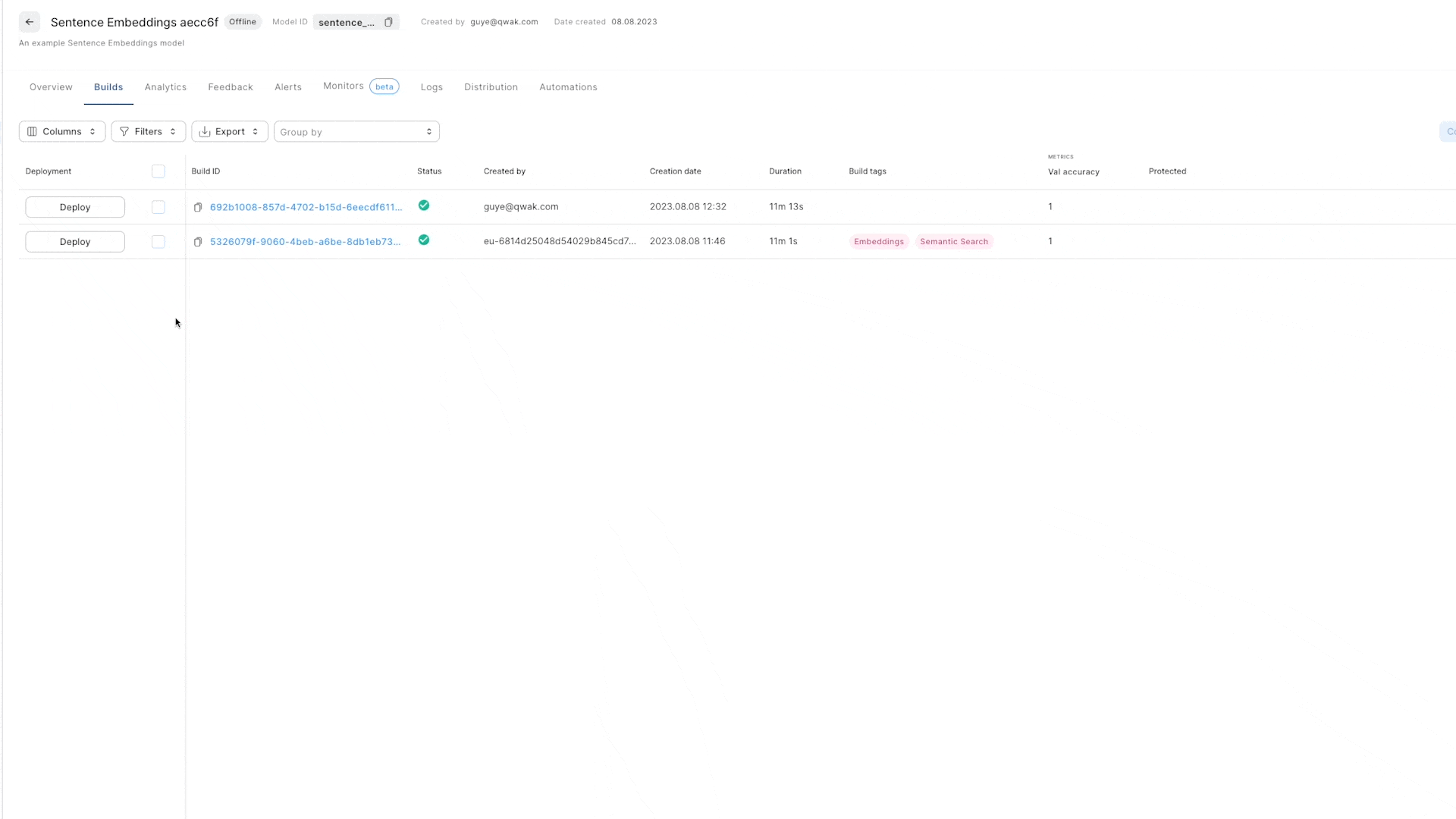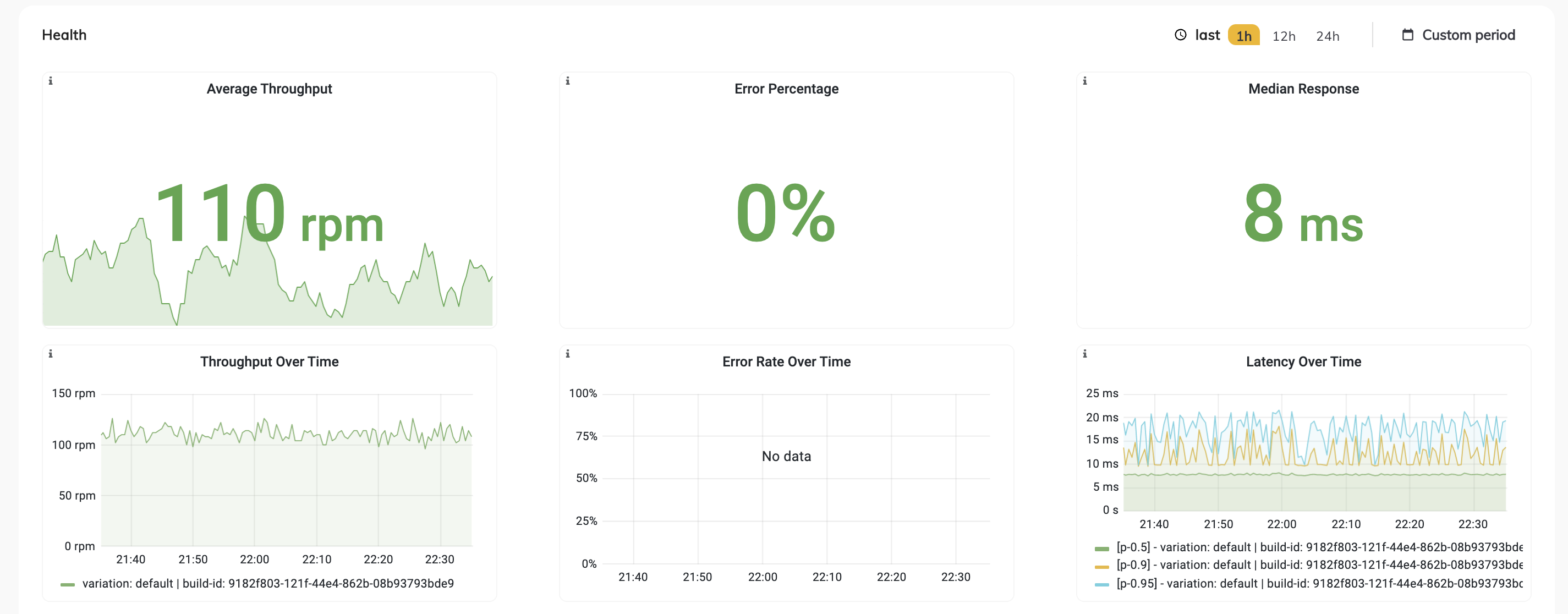Real-Time Deployments
Introduction
Qwak real time models deploy your ML models with a lightweight, simple and scalable REST API wrapper.
We set up the network requirements and deploy your model on a managed Kubernetes cluster, allowing you to leverage auto-scaling and security. Qwak also adds a suite of monitoring tools, simplifying the process of managing your model performance.
Deploying real-time models from the UI

To deploy a real-time model from the UI:
- Select Models in the left navigation bar
- Select a project and a model.
- Select the Builds tab.
- Choose a build and click Deploy.
- Select Realtime and then click Next.
- Configure your real-time deployment by selecting the instance type and the initial number of replicas.
- The Advanced settings configuration include additional options such as environment variables, invocation timeouts, and more.
Deploying real-time models from the CLI
To deploy a model in real-time mode from the CLI, populate the following command template:
qwak models deploy realtime \
--model-id <model-id> \
--build-id <build-id> \
--pods <pods-count> \
--instance <instance-type> \
--timeout <timeout-ms> \
--server-workers <workers> \
--variation-name <variation-name> \
--daemon-mode <bool>
For example, for the model built in the Getting Started with Qwak section, the deployment command is:
qwak models deploy realtime \
--model-id churn_model \
--build-id 7121b796-5027-11ec-b97c-367dda8b746f \
--pods 2 \
--instance small \
--timeout 3000 \
--server-workers 4 \
--variation-name default \
--daemon-mode false
Note: The deployment command is executed asynchronously by default and does not wait for the deployment to complete. To execute the command synchronously use the
--syncflag.
Deploying a real-time model using GPUs
Realtime models can be deployed on GPU instances, simply by selecting a GPU Instance from the available options.
qwak models deploy realtime \
--model-id churn_model \
--build-id 7121b796-5027-11ec-b97c-367dda8b746f \
--pods 4 \
--instance gpu.a10.xl \
--timeout 3000 \
--server-workers 4 \
--variation-name default \
--daemon-mode false
Configuring real-time models
The following table contains the possible parameters and variables for deploying real-time models.
| Parameter | Description | Default |
|---|---|---|
| Model ID [Required] | The Model ID as displayed on the model header. | |
| Build ID [Required] | The Qwak-assigned build ID. | |
| Variation name | The name of the variation to deploy the build on. | default |
| Initial number of replicas | The number of k8s pods to be used by the deployment. Each pod contains an HTTPS server, where a load balancer splits the traffic between them. | 1 |
| Instance | The required instance to deploy the model, either a CPU based instance or a GPU based instance. | Small |
| Timeout | The number of milliseconds required for an API server request to time out. | 1000(ms) |
| Concurrent workers | The number of Gunicorn workers handling requests. A positive integer is generally in the 2-4 x $(NUM_CORES) range. You may want to vary this a bit to find the optimal value for your particular application’s workload. | 2 |
| Daemon mode | Whether or not to Daemonize the Gunicorn process. Detaches the server from the controlling terminal and enters the background. | Enabled |
| IAM role ARN | The user-provided AWS custom IAM role. | |
| Max batch size | The maximal allowed batch size. | 1 |
| Timeout | The prediction request timeout. | 5000(ms) |
| Service Account Key Secret Name | The service account key secret name to connect with Google cloud provider | None |
Worker Memory Allocation
When deploying workers through an HTTP web server, it's essential to understand that each worker operates in its isolated memory space. Consequently, every worker independently loads a model instance into memory. This characteristic should be carefully considered when determining the required memory capacity for your chosen instance type, ensuring sufficient resources are available for all worker models to load and function optimally.
Using custom AWS IAM role
In some cases, a model needs to access external services during the runtime. If your model requires access to AWS resources, a custom AWS IAM role can be passed during the deployment process.
The IAM role should be created with the following trust policy:
{
"Version": "2012-10-17",
"Statement": [
{
"Effect": "Allow",
"Principal": {
"AWS": "arn:aws:iam::<account-id>:root"
},
"Action": "sts:AssumeRole",
"Condition": {
"ArnLike": {
"aws:PrincipalArn": "arn:aws:iam::<account-id>:role/qwak-eks-base*"
}
}
}
]
}
The IAM role ARN can be passed directly to a deployment using the --iam-role-arn flag. For example:
qwak models deploy realtime \
--model-id churn_model \
--build-id 7121b796-5027-11ec-b97c-367dda8b746f \
--pods 4 \
--instance small \
--timeout 3000 \
--server-workers 4 \
--variation-name default \
--daemon-mode false \
--iam-role-arn arn:aws:iam::<account-id>:role/<role-name>
Deploying real-time models locally
To run the deployment locally using a local Docker engine, use the --local flag. For example:
qwak models deploy realtime \
--model-id churn_model \
--build-id 7121b796-5027-11ec-b97c-367dda8b746f \
--local
Note: Deploying models locally is only available for locally generated builds using the
--no-remoteflag.
Real-time model inference
Once you have successfully deployed a real-time model, you can use the Qwak Inference SDK to perform invocations.
In this example, we'll invoke a model via the Python SDK, which can be easily installed using:
pip install qwak-inference
Model inference parameters are model specific.
For the below model, assuming it was built and deployed successfully as a real-time endpoint, with the model ID iris_classifier:
from qwak import api, QwakModel
from sklearn import svm, datasets
import pandas as pd
class IrisClassifier(QwakModel):
def __init__(self):
self._gamma = 'scale'
self._model = None
def build(self):
# load training data
iris = datasets.load_iris()
X, y = iris.data, iris.target
# Model Training
clf = svm.SVC(gamma=self._gamma)
self._model = clf.fit(X, y)
@api()
def predict(self, df: pd.DataFrame) -> pd.DataFrame:
return pd.DataFrame(data=self._model.predict(df), columns=['species'])
A prediction call from the Qwak Python SDK is:
from qwak_inference import RealTimeClient
model_id = "iris_classifier"
feature_vector = [
{
"sepal_width": 3,
"sepal_length": 3.5,
"petal_width": 4,
"petal_length": 5
}]
client = RealTimeClient(model_id=model_id)
response = client.predict(feature_vector)
Monitoring real-time endpoints
Qwak's endpoints are deployed on Kubernetes, coupled with advanced monitoring tools for production-grade readiness.
Qwak comes bundled with Grafana and Prometheus to provide monitoring dashboards, and ElasticSearch for log collection, amongst other tools.
The following health metrics appear in the model Overview tab:

In addition, you can follow and search the applicable logs produced by your model in the Logs tab:

Auto scaling real-time models
To attach a new auto scaling to a running model:
1. Create a config file:
api_version: v1
spec:
model_id: <model-id>
variation_name: <variation-name>
auto_scaling:
min_replica_count: 1
max_replica_count: 10
polling_interval: 30
cool_down_period: 300
triggers:
prometheus_trigger:
- query_spec:
metric_type: <cpu/gpu/memory/latency/error_rate/throughput>
aggregation_type: <min/max/avg/sum>
time_period: 30
threshold: 60
2. Run the following command:
qwak models autoscaling attach -f config.yaml
Configuration
| Parameter | Description | Default Value |
|---|---|---|
| min_replica_count (integer) | The minimum number of replicas will scale the resource down to | |
| max_replica_count (integer) | The maximum number of replicas of the target resource | |
| polling_interval (integer) | This is the interval to check each trigger on | 30 sec |
| cool_down_period (integer) | The period to wait after the last trigger reported active before scaling the resource back to 0 | 300 sec |
| metric_type (prometheus_trigger) | The type of the metric | cpu/gpu/memory/latency/error_rate/throughput |
| aggregation_type (prometheus_trigger) | The type of the aggregation | min/max/avg/sum |
| time_period (integer) (prometheus_trigger) | The period to run the query - value in minutes | |
| threshold (integer) (prometheus_trigger) | Value to start scaling for. cpu - usage in percentages gpu - usage in percentages memory - value in bytes Latency - value in ms Error Rate - usage in percentages Throughput - usage in RPM |
Updated 4 months ago
Next, let's look at the different options for performing real-time predictions
